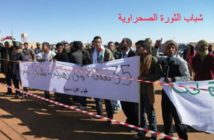Western Sahara is a block of land about the size of Colorado located in North Africa. Morocco considers it a southern territory, but many of its inhabitants want to be independent.
Map of Western Sahara

Western Sahara is a block of land about the size of Colorado located in North Africa. Morocco considers it a southern territory, but many of its inhabitants want to be independent. Read about significant dates in Western Sahara’s history. (Source: U.N.) Photo: Calvin Solomon
Sand Berm

A Google Earth satellite image shows the sand berm that crosses Western Sahara and one of the forts along it. The sand wall splits Western Sahara into the Moroccan-controlled west and Polisario-controlled east. Photo: Google Earth
Buried Tiles

Western Sahara has a population of about 523,000, according to the CIA World Factbook. Its main industries are fishing, phosphate mining and raising livestock, including camels and goats. Photo: Larisa Epatko
Laayoune Street

The city of Laayoune, which means “water sources,” is located about eight miles inland from the Atlantic Ocean. Photo: Larisa Epatko
Port Laayoune

Fishing activities in Morocco’s northern waters are restricted to rebuild stock. So fishing off Western Sahara’s coast has become more significant, both economically and politically. Photo: Larisa Epatko
Unloading the Catch

Fishermen at the Laayoune port use an assembly-line method to unload sardines, which will then be sold at an auction. Photo: Larisa Epatko
Full Crates

In addition to sardines (pictured here), fishermen catch bonito, tuna and octopus. Morocco exports sardines — without bones and skin — to the United States. Morocco’s exports of octopus to the United States are growing, some of the fisheries officials said. Photo: Larisa Epatko
Fishing Agreements

The European Union pays Morocco an annual fee to allow vessels, mainly Spanish ones, to fish off its shores. Sahrawis consider the deal controversial because they feel they don’t benefit from it. Photo: Larisa Epatko
Mining Phosphates

Western Sahara has one phosphate mine in Boucraa, southeast of Laayoune. Here, a gigantic crane scoops up the top rock and moves it out of the way to expose the crumbly phosphate rock beneath. Photo: Larisa Epatko
Phosphate Rock

The economical availability of phosphate rock will help in the area of global food security, some specialists say. Read about uses of and demand for phosphorus. (Source: Foreign Policy) Photo: Larisa Epatko
Conveyer Belt

Western Sahara has the longest conveyer belt in the world — 62 miles — which is used to transport the phosphate rock to awaiting international ships at the port of Laayoune. Pictured here is one of its feed points. Photo: Larisa Epatko
Water Source

A woman washes the hands of her child at a spring for which Laayoune was named. Photo: Larisa Epatko
Healing Properties

A Moroccan man from Rabat says the spring helped clear up his eczema skin disorder. He returns to Laayoune regularly to wash in its water. Photo: Larisa Epatko
Tea Preparation

Guests are often offered tea made with sugar and herbs. Read an NPR blog by Eliza Barclay about how the tea is intricately prepared. Photo: Larisa Epatko
Cookie Plate

A selection of sweets, dates and nuts are served with the tea. Photo: Larisa Epatko
Tagines at Market

Many meals in the Middle East and North Africa are cooked in an earthenware dish called a tagine. Photo: Larisa Epatko
Call for Independence

Larbass Abid is one of the younger Sahrawis who have taken up the cause of the territory’s independence from Morocco, saying action greater than peaceful protests might be needed to evoke change. Photo: Larisa Epatko
Aminetu Haidar

Sahrawi human rights activist Aminetu Haidar says use of non-violent resistance is what draws international strength to the Sahrawis’ cause. Photo: Larisa Epatko
Jailed Activists

Ali Salem Babait holds a portrait of fellow human rights activist Lmjiyed Sidahmed, who is in jail. The activists say 23 people are still imprisoned after the protest camp outside Laayoune was dismantled in November 2010. Photo: Larisa Epatko
Sahrawi Representation

Chukhi Sokaina, a Laayoune City Council member, was adamant that Sahrawis can act in their own self-interest. “This is our land and nobody else can control it or speak for us,” she said. Photo: Larisa Epatko
Mine Director

“I think the autonomy plan proposed by Morocco is the best way out of this conflict because it gives the population the right to its heritage and to run itself at the same time,” said Maoulainine Maoulainine, director of Phosboucraa Mine in Western Sahara, who was born in Tan Tan, Morocco. Photo: Larisa Epatko
Agreement?

A resolution to the conflict would benefit everyone, regional watchers say, though it looks like it might be a longer time coming. Photo: Larisa Epatko
.






